Easy Sourdough Flatbread
This easy sourdough flatbread is perfect for sandwich wraps, serving with meals, or just eating warm. The dough is an absolute dream to work with!
If you love baking with sourdough OR are just starting out on the sourdough baking train, this flatbread is a must-make. The bread is super soft and a little bit chewy with the best flavor!
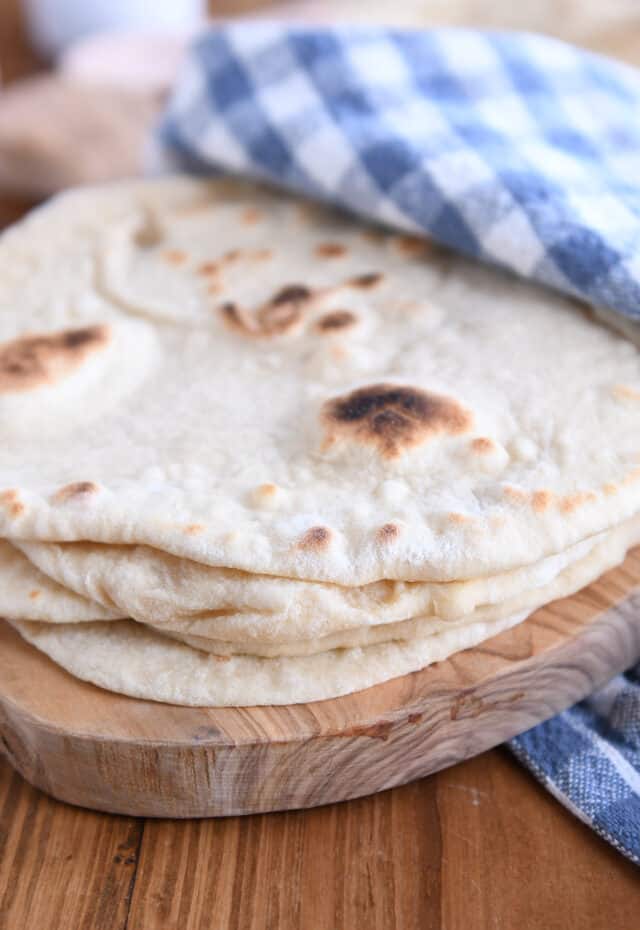
First, Let’s Talk Sourdough Starter
While many recipes call for sourdough discard (which means the sourdough starter can be used straight from the fridge without being fed first), this recipe relies on active or fed sourdough starter.
This means your sourdough starter needs to be ripe and bubbly before using so the dough can rise properly.
My sourdough starter is maintained with a 1:1:1 ratio. You can see from the photo below that it has the consistency of a thick batter. If your sourdough starter is thicker or thinner, you may need to adjust the flour amount in the recipe slightly (see the note in the recipe).
TIMING: This flatbread can be made in a few hours on the same day, so I suggest feeding your sourdough starter the night before so that is bubbly and active in the morning to use in this recipe.
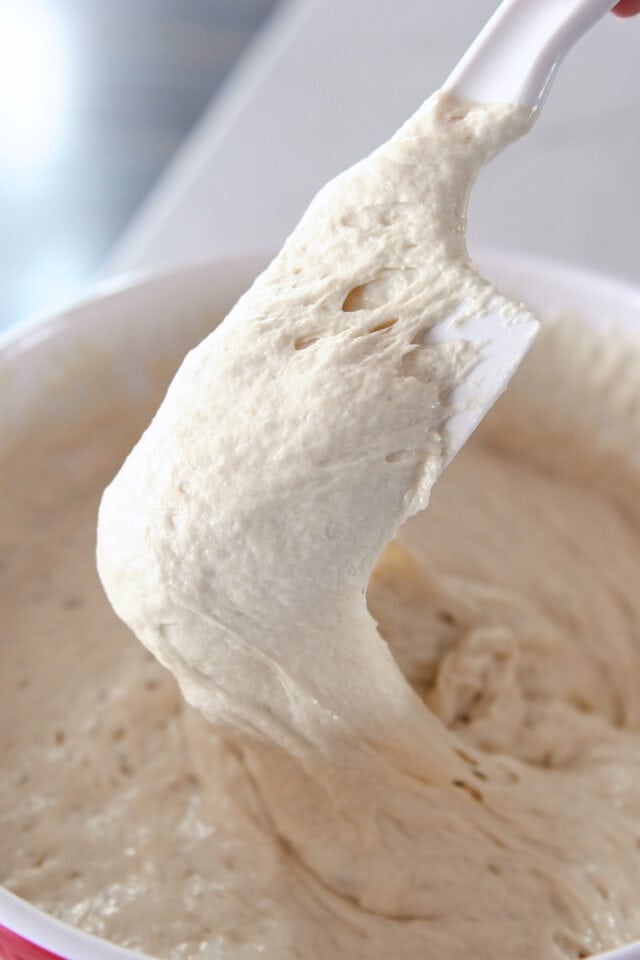
Easy Sourdough Flatbread Dough
The ingredients for this dough are thrown together in a bowl and mixed by hand.
- all-purpose flour (I use unbleached)
- fed sourdough starter
- olive oil
- water
- salt
The dough should form a soft, slightly shaggy ball that is easily indented without leaving a lot of dough residue on your fingers. Resist adding more flour if at all possible!
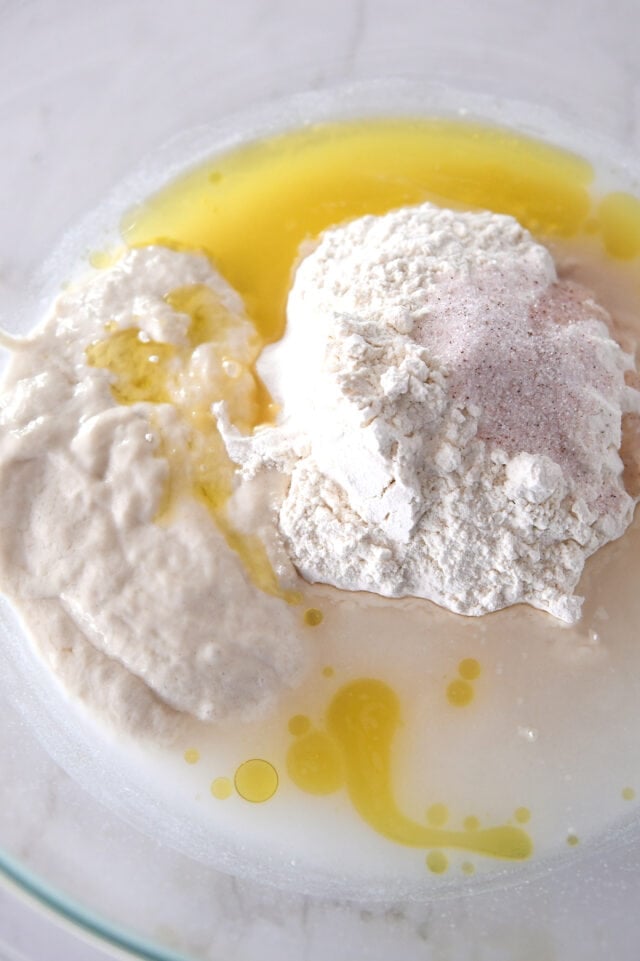
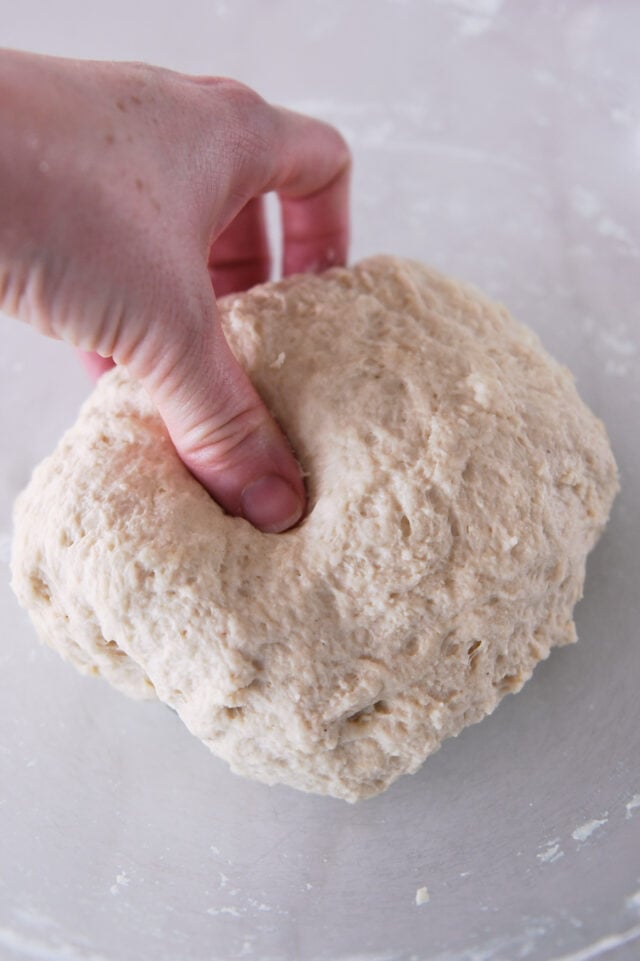
The dough needs to rise until doubled. This may take longer than a normal commercial yeast-based dough. It will rise more quickly in a warm, draft-free spot.
Separate the dough into ten equal pieces and let them rest on a lightly floured baking sheet for 20 to 30 minutes. This will help make them easier to roll out.
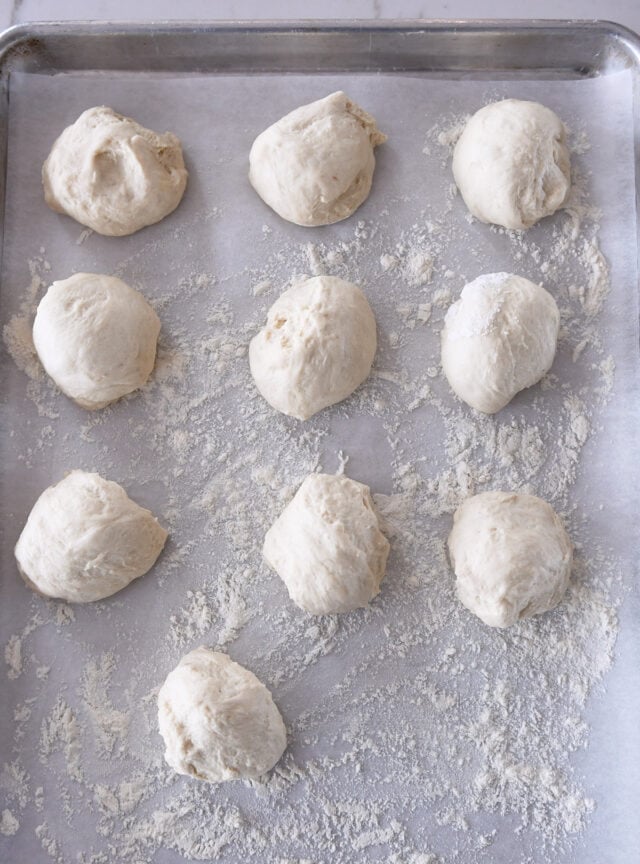
Rolling Out the Flatbreads
Roll each piece into thin circle on a lightly floured counter.
The exact dimensions and thickness will depend on how thick and puffy you want the finished bread. You can roll them super thin for tortillas or slightly thicker for a fluffy naan-type bread.
Take care not to add too much flour while rolling. The dough should stay very soft and pliable.
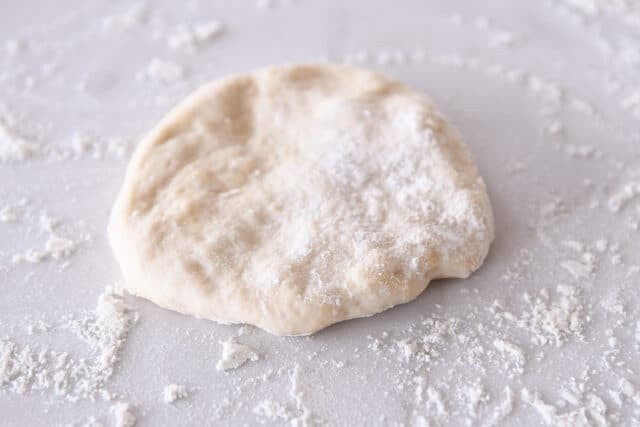
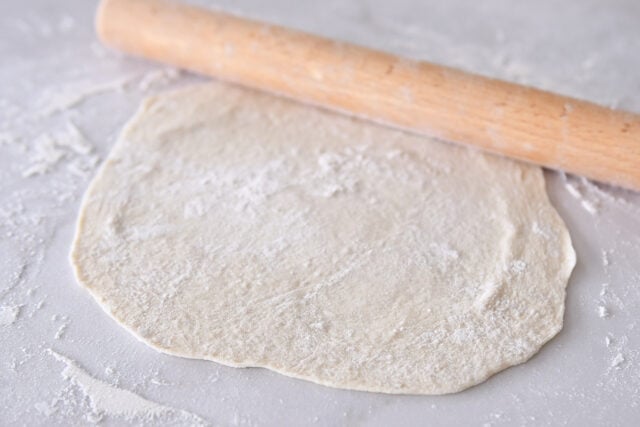
Cooking Flatbread in a Cast Iron Skillet
I like to use a cast iron skillet to cook this easy sourdough flatbread. It heats evenly and gives the best little bits of spotty golden color to the bread. The only downside is you can only cook one flatbread at a time.
So if you want to speed up the cooking process, a larger griddle could work well, too.
The flatbreads cook quickly! Just a few minutes on each side. The bread will puff a bit. The steam in these bubbles contributes to the soft, airy texture, so don’t pop them! Additionally, the golden spotty color develops when those bubbles are flipped over onto the hot cooking surface! Essentially what I’m saying is: bubbles are important here.
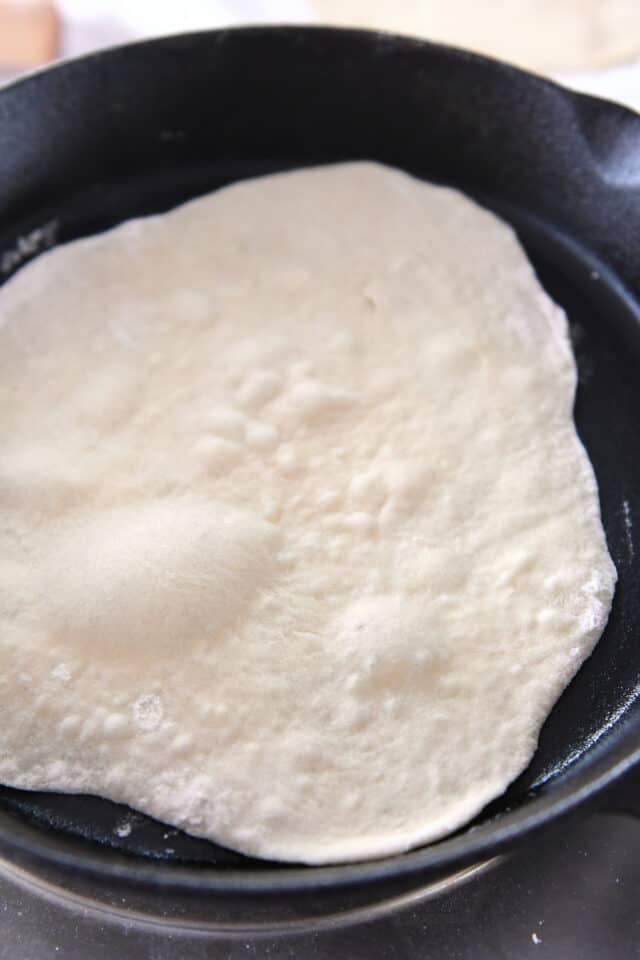
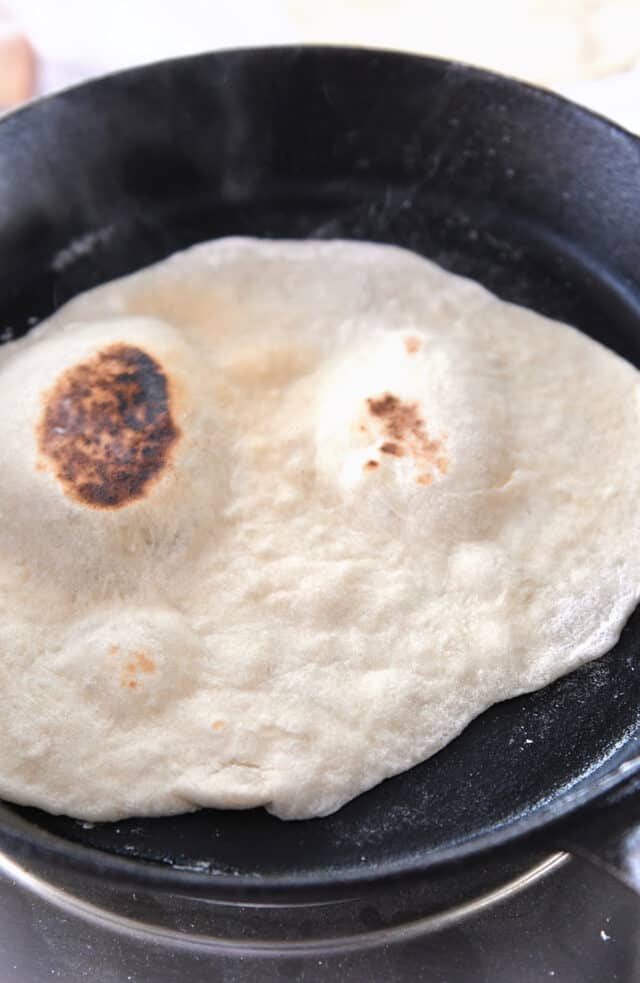
How to Serve Sourdough Flatbread
This easy sourdough flatbread is perfect for so many different style of meals.
- roll and cook them thin and use as tortillas for tacos or other meals where you need a “soft shell” for eating
- roll and cook them slightly thicker for Indian-inspired meals like quick curry or this easy basil curry (we love them with this egg roll skillet meal!)
- roll out the dough and use for individual (or maybe larger?) pizzas! I think you could easily cook them in an air fryer or on a pizza stone or baking sheet in a 450 degree F oven
- cook and cool the flatbread and use for any variety of sandwiches or wraps
I like to hide one or to leftover flatbreads from the other humans in this house so I can take them (the bread, not the humans) and roll them up with ham, swiss and a drizzle of mustard. My favorite lunch. SO GOOD.
However, once you try a piece of this sourdough flatbread hot off the skillet with a touch of butter and honey, you may not ever have any bread actually make it to its predestined purpose, let alone leftovers.
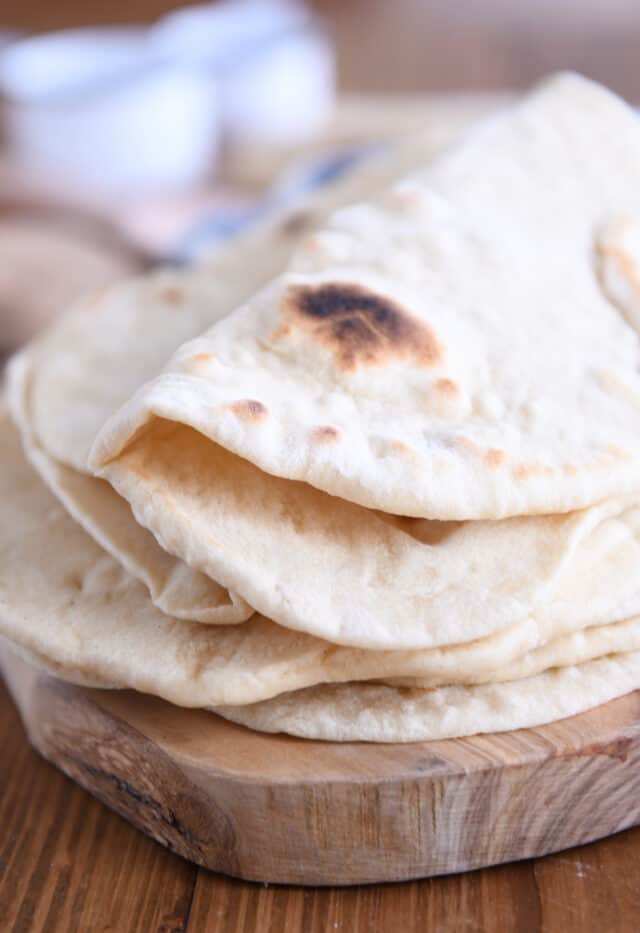
The Best Flatbread
If you have the time to prep sourdough starter, this flatbread wins out over even the other flatbread recipes on my site, because:
- the dough is SO pliable and easy to work with
- the cooked flatbread stays soft and yummy for days
- the flavor is more complex than your basic bread without overpowering with too-tangy sourdough flavor
This is definitely one of my favorite recipes; I’ve been so excited to share it with you!
If you are new to sourdough and don’t know where to start, here’s a quick post that can help you figure it out. I embrace sourdough the lazy girl way. It doesn’t have to be high maintenance!
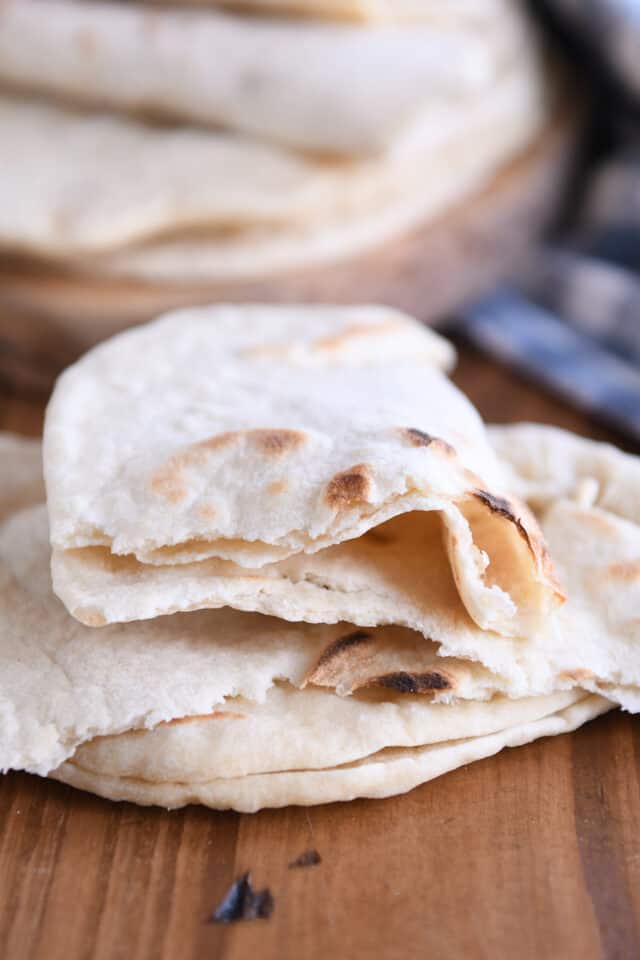
One Year Ago: Crispy Chicken Enchilada Wraps
Two Years Ago: Healthy Applesauce Oat Muffins
Three Years Ago: Easy Amish Baked Oatmeal {Overnight Option}
Four Years Ago: Healthy Breakfast Cookies {Perfect for Snacks Too}
Five Years Ago: Instant Pot Banana Bread Steel Cut Oats
Six Years Ago: Perfect Instant Pot Beef Stew
Seven Years Ago: Southwestern Chicken Barley Chili
Eight Years Ago: Perfect Roasted Vegetables {5 Simple Tips}
Nine Years Ago: Chicken Tikka Pizzas: Another 20-Minute Meal
Ten Years Ago: Light Lemon and Spinach Spaghetti
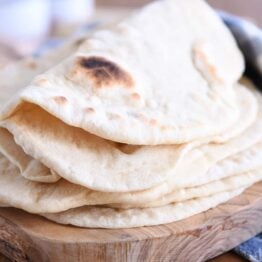
Easy Sourdough Flatbread
Ingredients
- 2 ½ cups (355 g) all-purpose flour
- ¾ cup (175 g) warm water
- ⅔ cup (175 g) fed/active sourdough starter
- 2 tablespoons (25 g) olive oil
- 2 teaspoons (10 g) salt
Instructions
- To a large bowl, add the flour, water, sourdough starter, olive oil and salt. Mix with a wooden spoon or spatula until the dough comes together (I use my hands at the end of mixing to help). Knead a few times until the dough forms a soft ball. Resist adding extra flour unless the dough is too sticky to work with.
- Cover the bowl and let the dough rise in a warm spot until doubled, anywhere from 2 to 6 hours. This may take longer than a normal commercial yeast-based dough. A warm, draft-free spot will help the dough rise more quickly.
- Dust a parchment-lined baking sheet with flour. Set aside.
- Split the dough into ten equal pieces, about 65 to 75 g each. Form each piece into a ball by turning the ends underneath. Place several inches apart on the prepared baking sheet.
- Let the dough rest for 30 minutes.
- On a lightly floured counter, roll each piece into a thin 6- or 7-inch circle. It doesn't have to be perfect – it's ok if the edges are a bit wavy.
- Cook the flatbread in a hot skillet or on a preheated griddle for 1 to 2 minutes on each side until golden in spots and cooked through. It will likely bubble and puff as it cooks – don't pierce the bubbles.
- Serve the flatbread warm or at room temperature. It stores very well for several days in a sealed bag (it also freezes well).
Notes
Recommended Products
Recipe Source: from Mel’s Kitchen Cafe

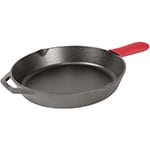
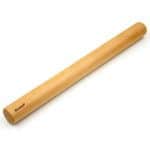
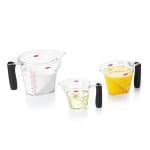
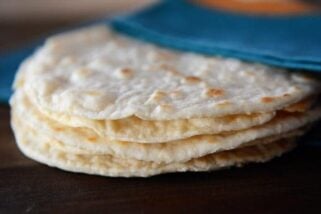
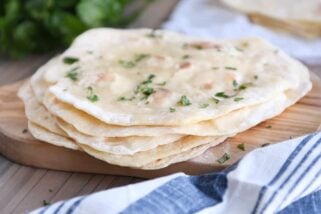
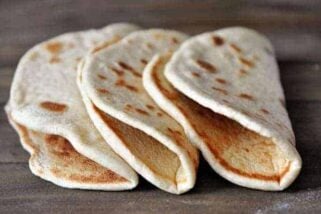
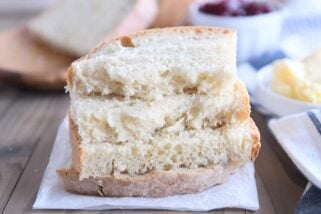
Do I let it double in size before putting it in the fridge to roll out the next day?
No, pop it in the fridge before letting it rise. It’ll likely puff a bit in the fridge…then just take it out in time to puff/rise more if needed.
I have looked for a sourdough recipe for Olga’s pita bread. It has honey in it. Do you think I could modify this recipe with honey? Thank you
Definitely worth a try!
Yes, absolutely loved it Mel. Thank you very much. Posted your recipe on my Substack – it was easy to follow. I look forward to trying more out. I am new to sourdough, so fun. Thank you very much!
Wendyhenry@substack.com
Thank you for all your great recipes! I’ve made your homemade flatbread and we all enjoy it except like you said it’s best eaten the day it’s made. I was excited to try this since you described it as being very soft and keeps well for several days.
I made this twice following your recipe even weighing the ingredients. They came out good but not as soft and did not keep as well as I thought it should. What can I be doing wrong? Any idea? I’m going to try it again but would like your input on how I could improve. Thank you!
Hi Lin, the bread can dry out a bit if it’s over cooked on the skillet/griddle, so keep an eye on that. Also, what is the texture of your dough? Is it on the stiff side? Or soft?
I’m trying the recipe again and I think my dough may be slightly on the stiffer side. Should I cut down on the flour a little? I do use a scale to weigh my ingredients.
Yes, try less flour (maybe 1/4 cup or so). The stiffness could be due to the difference in our sourdough starters (thinner or thicker consistency).
Do you think would work to do the long rise overnight in the fridge?
Yes, I think you could definitely do that.
These were my very first sourdough recipe to try. Huge success! Thanks for sharing you sourdough tutorial and this recipe. I’m excited to try some of you other sourdough recipes and recommendations.
My family gobbled these up plain, and with cream cheese in kids’ lunches! I preferred the ones that I cooked on the griddle with a spritz of olive oil vs those I cooked dry. I need to figure out a way to make these on weeknights where I don’t have time for the full process in the evening!
These were delicious! It does take planning, but a little ham, gourmet cheese and it’s amazing! I didn’t get a very good taste of this when they were hot off the griddle, but the day after they were superb.
I meant that I didn’t taste them when they were fresh (planning problem on my end)
This recipe came just in time for some fed starter I had and didn’t know what to do with. I’ve made it twice now and it is delicious and very straight forward. The second time I made them I doubled it and cooked half that night and put the rest of the dough balls in the refrigerator to cook the next day. Those turned out great, too!
Thanks for another great recipe! I don’t get on here and thank you enough for all the amazing recipes you continue to share! We so appreciate you!
Thank you so much, Rachel!
Wow! These are fabulous and so easy to make! I had chicken schwarma on the menu for this week, but forgot to buy flatbread and then this recipe popped up. What fortuitous timing! And I’m always looking for ways to use some sourdough starter. This morning I made a breakfast taco using one of the flatbreads and it was delicious. Five star recipe!!
Thanks so much for making this recipe and letting me know your thoughts, Katie! A breakfast taco with this flatbread sounds super delish!
The texture was amazing, but they were too salty for us. I’ll probably reduce the salt by half next time.
Thanks for the feedback, Jenny.
Do you stir the sourdough to release the bubbles before measuring out?
I give the starter a quick stir and then measure.
Made it for dinner tonight! Paired it with your Greek chicken recipe. It was delish!
Thanks for letting me know, Cherice!
Mel have you tried this one with partial or all whole wheat flour? I will probably do that, but curious about your results. Thanks so much.
Hi Vickie – I’ve made these using 1 cup whole wheat flour (freshly ground einkhorn wheat) and 1 1/2 cups all-purpose flour. They were really good – a bit less light and fluffy but still delicious.
Hi! I love your recipes so so much and I’m excited to try this out as I’m about to receive some starter from a friend. Quick question. When you say olive oil, do you mean refined olive oil as opposed to extra virgin? My usual neutral cooking oil is avocado oil and I have extra Virgin olive oil. If it’s extra virgin we’re looking for, I’m set! If not, would you guess avocado oil would be fine?
I use extra virgin olive oil. Sorry for the confusion!
I’ve been making your yogurt flatbread on repeat these past few weeks. I cannot wait to make these! Sounds like I need to double the recipe.